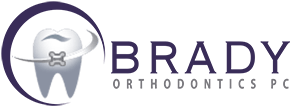Orthodontic Hygiene
Introduction
Menu
Now that you have your braces in place, it's even more important to maintain good hygiene during your treatment. Braces, wires, bands and retainers can trap food particles and make it difficult to brush or floss away plaque. Careful brushing and flossing, preferably after every meal and snack, is the best way to prevent plaque build-up, tooth decay and gum disease.
You can learn more about proper orthodontic hygiene by clicking on the buttons for each particular topic.
- Step 1
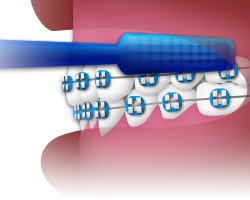
Start with the outside of the teeth, with the brush flat against the surface of teeth. Use circular, vibrating motions.
- Step 2
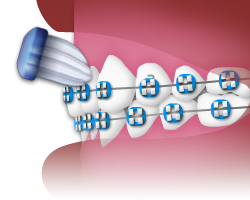
When brushing your top teeth, clean the area between the gums and braces by angling the brush downward. Keep moving in small, circular motions.
- Step 3
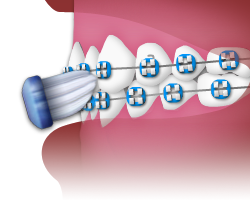
When brushing the lower teeth, angle the brush upward.
- Step 4
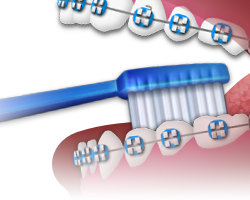
Carefully brush the chewing surfaces of both the upper and lower jaw.
- Step 5
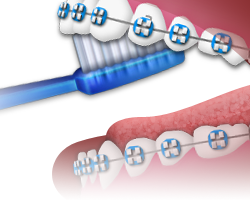
Finish by brushing the inside of the teeth.
- Step 1

Floss at least once a day. You need to pull the floss under the archwire with a floss threader. Start by pulling floss through the threader.
- Step 2

Push the end of the floss threader under the archwire and pull the floss through.
- Step 3
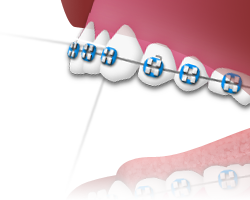
Pull the floss up between the teeth and gently move it up and down the side of both teeth. Remember to move it up all the way under the gums.
- Step 4
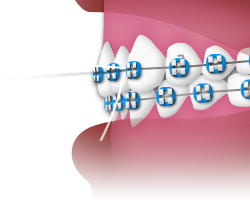
Pull the floss out and use a different section of it for the next tooth.
- Step 1
- Step 2
- Step 3
- Step 4

When you're finished brushing and flossing, rinse your mouth thoroughly with water or an antiseptic dental rinse. An antiseptic rinse can help minor gum inflammations and irritations from orthodontic appliances, as well as cleanse canker sores and other minor wounds. It can also remove debris or irritants from the mouth, speeding up your body's natural healing process.

Using an interdental toothbrush (proxabrush) can help keep your teeth, braces and gums clean and healthy. Use this device slowly and carefully to clean under orthodontic wires and around braces, taking care not to damage your braces.

Since retainers can accumulate food particles and plaque, brush your retainer every time you brush your teeth. Also soak your retainer once a day in a glass of room-temperature tap water with a denture-cleaning tablet. This will help prevent plaque build-up and oral infections and keep it tasting better. DO NOT use hot water, which can distort the appliance.

During your first week in braces, stick to a soft food diet until any discomfort subsides. Afterward, you can eat just about anything while wearing braces, with a few exceptions.
You should avoid hard foods like ice and pizza crust, as well as sticky foods such as caramels and chewing gum, since they can damage wires and brackets. Also minimize sugary foods like ice cream and cookies, and reduce sugared drinks like soda or milk to once a day.
The best way to ensure a clean and healthy smile is brushing and flossing. Food particles can accumulate on teeth and in braces, and over time, turn into plaque. The bacteria that results from this accumulation can lead to gum disease, tooth decay and even loss of teeth. To avoid these problems while you are in orthodontic treatment, take special care of your braces, teeth and gums to ensure you will have the best possible result.
Brushing
Use a toothbrush with soft bristles and a small strip of fluoride toothpaste. When you brush your teeth, move the brush in small, circular motions to reach food particles that may be under your gum line. Hold the toothbrush at an angle and brush slowly and carefully, covering all areas between teeth, between braces and the surface of each tooth. It will take you several minutes to thoroughly brush your teeth. Brush up on the lower teeth, down on the upper teeth and the outside, inside and chewing surface of your front and back teeth. Brush your tongue and the roof of your mouth before you rinse.
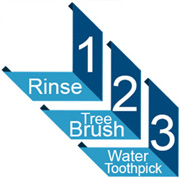 Especially during orthodontic treatment, brush your teeth four times daily to avoid the accumulation of food particles in your teeth and braces:
Especially during orthodontic treatment, brush your teeth four times daily to avoid the accumulation of food particles in your teeth and braces:
- In the morning after breakfast
- After lunch or right after school
- After supper
- At bedtime
You will need to replace your toothbrush more often due to your appliances. As soon as the bristles start to wear down or fray, replace your toothbrush with a new one. It may be difficult for your toothbrush to reach some areas under your archwire. Do not swallow any toothpaste; rinse your mouth thoroughly with water after you finish brushing. It is important to floss and use an antibacterial mouthwash and fluoride treatment throughout your orthodontic treatment and beyond for optimal oral hygiene.
Flossing
For areas between the teeth that a toothbrush can't reach, use dental floss to remove food particles and plaque. Flossing takes more time and patience when you are wearing braces, but it is important to floss your teeth every day.
Use the reusable floss threader provided by our office to floss under your archwire daily. Pull a small length of floss from the dispenser through the threader and slide it up and down along the front of each tooth. You will be able to feel when the tooth is clean and hear the squeak of the floss against your clean teeth. Use care around your archwire and do not floss too forcefully around it or put too much pressure on it. After you floss between your archwire and braces, floss between your other teeth and gums.
If you are flossing without the floss threader, pull a small length of floss from the dispenser. Wrap the ends of the floss tightly around your middle fingers. Guide the floss between all teeth to the gum line, pulling out food particles or plaque. Unwrap clean floss from around your fingers as you go, so that you have used the floss from beginning to end when you finish. Floss behind all of your back teeth.
Floss at night to make sure your teeth are clean before you go to bed. When you first begin flossing around your braces, your gums may bleed a little. If the bleeding does not go away after the first few times, inform a staff member at your next appointment.
